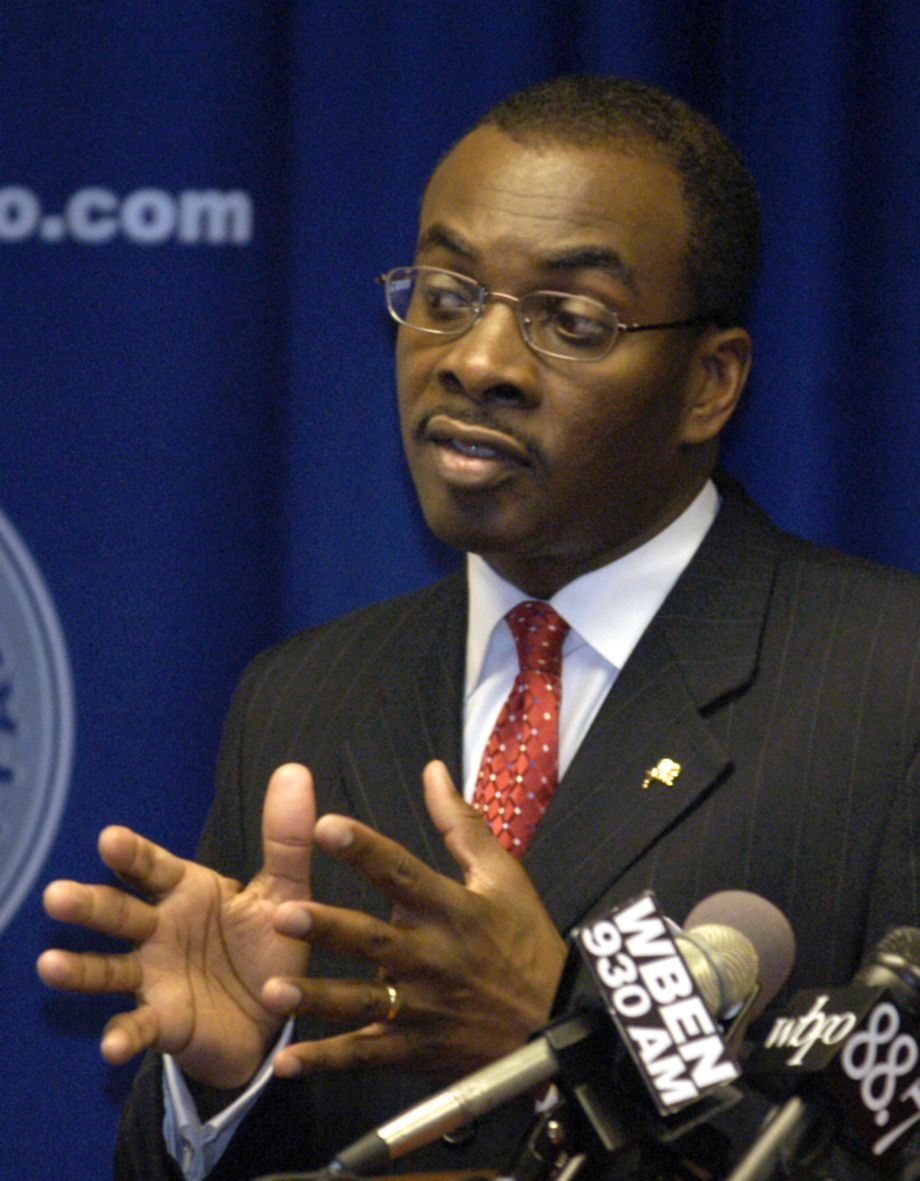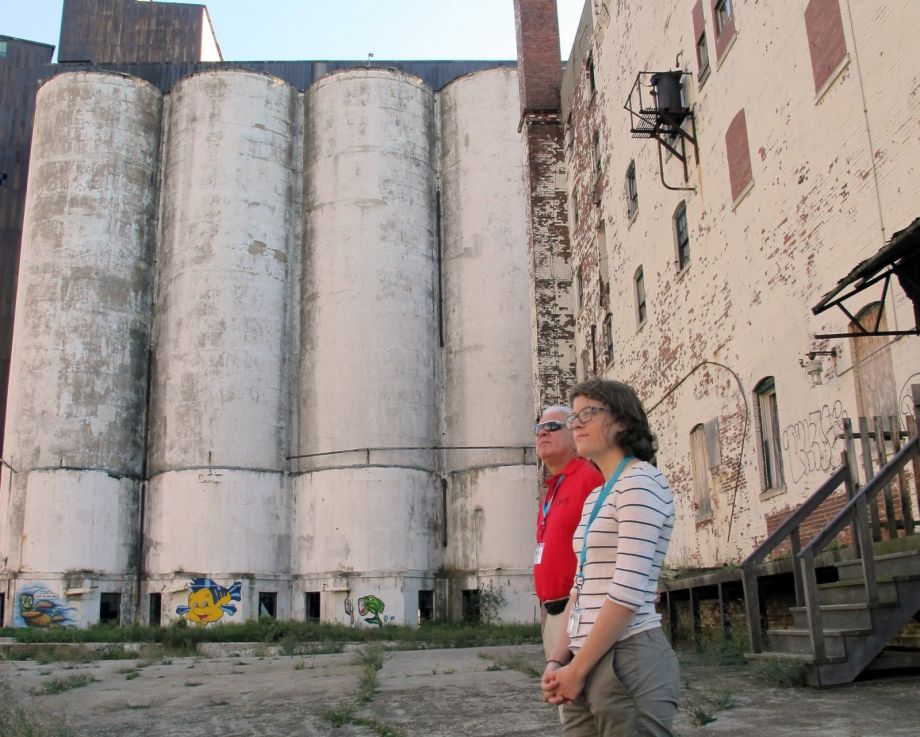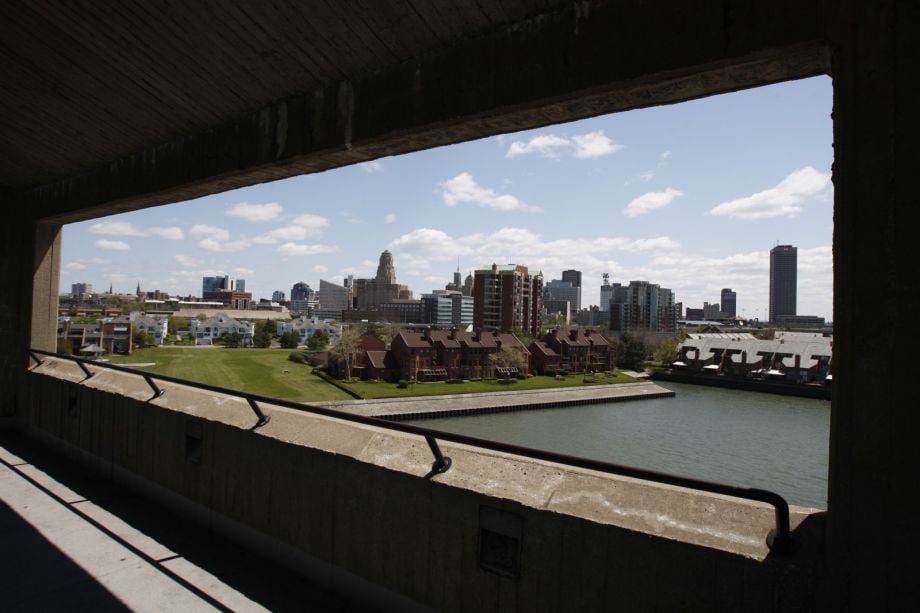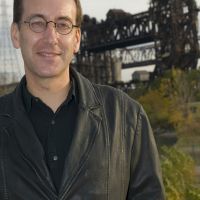Are You A Vanguard? Applications Now Open
Credit: ESD
This is your first of three free stories this month. Become a free or sustaining member to read unlimited articles, webinars and ebooks.
Become A MemberOn a warm evening late last spring, I took a kayak tour of the Buffalo River, because I wanted to see how Buffalo has transformed a derelict industrial waterway into a nautical playground. I rented my kayak at Canalside, a park built around the unearthed terminus of the Erie Canal, the waterway that 191 years ago made Buffalo a major Great Lakes port. Our tour flotilla passed powerboats, a jet ski, a rowing crew and a stand-up paddleboarder.
On the east side of the channel was River Fest Park, with a band shell for classic rock concerts every summer Wednesday, and the Tewksbury Lodge, which hosts weddings and class reunions. Alongside the park, I saw the under-construction Buffalo River Landing, a 78-unit riverfront apartment building scheduled to open next year.
We paddled past the General Mills plant, which broadcasts a sweetish kettle-corn odor that causes Buffalonians to boast that the city smells like Cheerios. The plant was built when Buffalo was the granary of the East, the last stop for oats from Duluth, before the Saint Lawrence Seaway allowed cargo to bypass the city on its way to the Atlantic Ocean. As the river uncoiled, I saw another grain elevator, rising 10 stories above the bank. It was tagged with graffiti. A rusting skeleton showed through its flaking concrete walls. Every bend on the stretch of river known as Elevator Alley revealed another empty silo bearing a brewery’s faded logo: Schmitt’s, Cook’s, Carling, Fred Kuck Malting. The gray cylinders were tombstones for Buffalo beers.
Buffalo is the birthplace of the grain elevator yet this area had until quite recently been regarded as a graveyard of white elephants too obsolete to be useful and too expensive to demolish. No longer. Today, the area has been rebranded as Silo City. Tourists pay money to see the inside of the aging industrial artifacts. There is a climbing wall, a flea market and light shows that project on the blank gray hulks. In shops around the city, one can purchase T-shirts and postcards where the silos appear, celebrated as symbols of Buffalo’s classical grandeur. After kayaking in at dusk, I ate fish tacos and drank a local beer at the Liberty Hound, a Canalside restaurant right next to the naval museum. My table was a few feet from the World War II destroyer USS The Sullivans.
I made the exact same trip in the summer of 2005 — and saw a very different Buffalo River. There were no kayaks on the water. The only sign of life on shore was a cluster of boys dipping lines into the water, angling for fish too poisonous to eat, because the river bottom was polluted with undigested toxins from the industry that had used the river as a gutter for decades before closing shop. That trip had felt peaceful and eerie at the same time, like a visit to an abandoned city in a dystopian science-fiction movie.
“There’s very few things that Buffalo has done perfectly,” my boat pilot told me that day. “They have perfectly separated the citizens from the waterfront.”
Today, that is no longer true. Buffalo has reinvented its waterfront and in the process, become a model that other legacy cities are looking to as they strive to reconnect with their rivers and lakes.
Buffalo Mayor Byron Brown entered City Hall five months after my first ride past a then-grim Elevator Alley. On the day of his inauguration, he went to that same spot and vowed a transformation. His predecessor had been working on bringing a big-name retailer to the waterfront but the project had raised flags and momentum was building in the city for a new vision. Within a few months, Brown had flown to Baltimore to see its Inner Harbor and learn how another formerly industrial city had turned its abandoned warehouses into an international tourist attraction.

Buffalo Mayor Byron Brown answers a question during a news conference announcing the city's plan for the waterfront development project. (AP Photo/Don Heupel)
The mayor, the first African-American elected to the office, had a big job ahead of him. Nearly a third of the city’s population was living in poverty, making it the third poorest big city in America, according to census figures. Long simmering economic troubles and a budget deficit of more than $100 million had put the city under the control of a state-imposed financial oversight board and a separate state advisory board. Brown was elected with a mandate to loosen state control over the city and reverse decades of job and population loss that extended far beyond the Elevator Alley.
But the waterfront “weighed very heavily in Buffalo’s transformation from industrial to postindustrial,” says Brown. A space can become shorthand for an entire city and the grim shore of the river was telegraphing a message that Buffalo no longer wanted to send.
The mayor wasn’t working alone. Much of the money for waterfront redevelopment would come from an agreement negotiated between Buffalo officials and New York Power Authority that gave the state a 50-year license to draw energy from Niagara Falls in exchange for $7 million annually for communities whose waterfronts had been despoiled by industries drawing on the authority’s power.
“The Buffalo waterfront was an industrial, working waterfront,” says Rep. Brian Higgins, the Democratic congressman who led the negotiations. “The demise of industry left the waterfront polluted. Money had to be used to mitigate damage to the waterfront.”
And it was. The deal with the power authority made it possible for the city to develop Canalside, the nautical-themed park at the mouth of the Erie Canal, and tear down an old sports arena to make way for new canals that become public ice skating rinks in the colder months. A new authority — The Erie Canal Harbor Development Corporation — was created to spearhead the building.
With these infrastructure investments and a new organization tasked with development in place, developers began to see what had been blight as an opportunity. In 2014, an office building that had been empty for 20 years reopened as posh One Canalside, with a hotel and law firm as tenants.
That same year, an ice hockey-themed mixed-use development called HarborCenter opened its doors on land that had been a surface parking lot before Terry Pegula, who owns the Buffalo Sabres, the city’s popular National Hockey League team, bought it from the city for $2.2 million. Though the heavily subsidized development was controversial, it has made Buffalo a more attractive destination for those on the hockey circuit. This year, the complex hosted the annual College Hockey America tournament.
Doug Swift is another entrepreneur drawn to the waterfront by public investment in the area. In 2015, Swift opened RiverWorks, an entertainment complex a half-mile upstream from HarborCenter on a once-industrialized peninsula between the river and the ship channel. He built a restaurant with a patio overlooking the water, and a rink that hosts 120-team hockey tournaments in the winter and the Queen City Roller Girls in the summer. Next door, he wrapped a six-cylinder silo that has not stored grain since the 1960s, in blue sheeting to look like a six-pack of Labatt’s, as an advertisement for the craft brewery about to open there.
In 2018, a children’s museum will open on the last remaining sliver of the old sports arena site the city and state began redeveloping a little more than a decade ago.
“What we’re seeing with the Buffalo waterfront is that when we made the public investment in infrastructure to make the waterfront more attractive and more accessible, it’s also become more attractive to private sector investment,” says Higgins. For the congressman, the numbers prove the strategy.
“So you saw … a $35 million investment, which leveraged over $200 million in private sector investment,” he says. “That was not coincidental. It’s a cause and effect relationship.”
Brendan Mehaffy, executive director of the city’s Office of Strategic Planning, estimates that waterfront development projects have created “thousands of construction jobs and easily over a thousand permanent jobs.”

Visitors tour a collection of grain elevators that loom over the Buffalo waterfront. (AP Photo/Carolyn Thompson)
Aaron Bartley is the executive director of PUSH Buffalo, which stands for People United for Sustainable Housing. He remembers numerous public meetings about the fate of the waterfront. At one point, the area was slated to be given over to Bass Pro for a massive development that would have created a heavily subsidized, privatized waterfront. Once that plan was abandoned, the city was able to reimagine the future of the space, and that process, he says, led the city toward a more inclusive vision. There is public art on the waterfront, open space and free pop-up cultural offerings for residents seeking a cheap date. “There has been a move towards partial privatization but by and large, the development is a successful public space.”
Bartley knows that some of the low-income families that belong to his membership-based organization depend on service sector jobs on the revitalized waterfront, but much of the work is seasonal and it is not a huge employment center, he says. (PUSH is focusing its economic development efforts on a medical district expanding about 2 miles northeast of the waterfront.)
Bartley sees the waterfront development not as a job generator, but rather as part of a strategy to attract a new population to the city: the middle class. That too, he says, is essential. The new hotels, offices and tourist attractions are bringing much-needed capital to a community where 47.3 percent of children live in poverty, the third-highest rate of any American city. “It’s imperative that Buffalo is not a dying place anymore,” he says. “There’s more potential for the long-term sustainability of an urban public school system now that there is a tax base.”
But Bartley wants to ensure that people who lived in Buffalo during its ragged years aren’t displaced. During Buffalo’s industrial era the waterfront was, in the words of local historian Mike Malyak, “a real red-light district,” the playground of Great Lakes sailors who crashed at the 25-cent-a-night Seaman’s Rest and cavorted with prostitutes, who were tolerated as long as they solicited customers no farther inland than the flagpole at Main and Commercial streets. When the city finally demolished the taverns and flophouses, it replaced them with the Marine Drive Apartments, a public housing project still standing next to Canalside. Bartley is concerned about the housing project’s survival, now that waterfront land is desirable again.
“There is this dominant narrative of the rebirth of the city and there is some truth to that, but we have the benefit of seeing how renaissance narratives limit the opportunity for residents of color, low-income people, to stay in renaissance cities,” he says. “It’s our position that it needs to be clarified that Marine Drive remain affordable housing.”
Buffalo’s reclamation of its waterfront may never have happened if not for years of determined work by people like Jill Jedlicka, executive director of Buffalo Niagara Riverkeeper, which oversees the 1,400-square-mile Niagara River watershed. Jedlicka keeps a photo in her office of her great uncle, Stanley Spisiak, touring the Buffalo River with New York Sen. Robert F. Kennedy. In the mid-1960s, the river was biologically dead, so polluted that no fish could survive in its waters. It was a toilet for factories and a highway for freighters, whose visits were so common they crowded out all other navigation. Spisiak invited Gov. Nelson Rockefeller and President Lyndon Johnson to Buffalo. After seeing a bucket of sludge lifted from the river, Johnson signed an executive order prohibiting dumping of dredged spoils into Lake Erie. Like the Cuyahoga River in Cleveland, it even caught fire in the late 1960s.
“My grandparents lived a quarter mile from the river, but I didn’t really know there was a Buffalo River, even though I had an affinity for playing in rivers and creeks,” Jedlicka remembers. “Most people didn’t know where the river was. It had been hidden in plain sight, walled off by brownfields and concrete. Now, it’s an integral part of the community.”

The city of Buffalo is shown from a Lake Erie waterfront overlook tower in Buffalo. (AP Photo/David Duprey)
After the Clean Water Act was passed in 1972, fish began returning to the river, beginning with sheepshead. But the federal projects that really revived the Buffalo River were the 2002 Great Lakes Legacy Act and the 2010 Great Lakes Restoration Initiative. They provided funding to dredge the last 6.2 miles of the channel. The Army Corps of Engineers, which is responsible for maintaining the Buffalo River as a navigable waterway, and the Buffalo River Restoration Partnership, a consortium of government agencies, business and nonprofits overseen by the Riverkeeper, hauled up 1.1 million cubic yards of sediment tainted with PCBs, polyaromatic hydrocarbons, lead and mercury. After the dredging was completed, the restoration project began work on shoreline improvements.
“One effect is to erase the stigma of the Buffalo River being ‘kinda crappy’ to a place people want to be,” says Army Corps hydrogeologist Bill Frederick.
At Buffalo Harbor Kayak in Canalside, rentals boomed after the cleanup, says General Manager Justin W. Dahl. When the livery opened eight years ago, it guided two tour groups a month. Now, it’s open every day — a small example of how Buffalo’s environmental health contributes to its economic health. At the same time the river was dredged, the Buffalo Sewer Authority built a control facility to prevent the Hamburg Drain from dumping overflowing stormwater and sewage into the river.
“The cleanup did so much,” Dahl says. “Two years ago, you couldn’t see 6 inches down. It was brown. And after a rain, nobody wanted to be in the river. We would get floaters in the river. We’d see condoms.”
Last year, Buffalo Harbor State Park, the city’s first state park, opened alongside a tired sailboat marina not far from Dahl’s old cleanup grounds in an area called the Outer Harbor. It has a children’s playground, a bar and restaurant, and a beach for launching jet skis and sailboards. Spots for fishing cut into the guard wall surrounding the freighter slip. Under construction is a promenade atop the breakwall, where Buffalonians can finally watch the Lake Erie sunsets they’ve been blocked from viewing since the beginning of the Industrial Revolution. A grassy promenade topped with shimmering mobiles offers another new-to-Buffalo view, says the park’s designer, Dean Gowen. “You can see Canada, and you can see the open lake. Nobody in Buffalo saw the open lake before, because of the breakwall.”
The last remaining blight on the lakeshore is Freezer Queen, an empty frozen foods warehouse whose peeling whitewash makes it look like a gigantic oxygen-deprived fish that beached itself to die. Developer Gerald Buchheit wants to replace it with Apartments at Queen City Landing, a 23-story tower that would be Buffalo’s first true lakefront living complex.
John Norquist, the former Milwaukee mayor and president of the Congress for the New Urbanism, once said that the “dead gray hands” of highway-loving city planner Robert Moses “are still strangling the city of Buffalo.” Norquist was referring to the New York State Thruway that Moses routed right along the Niagara River, but the New York planner’s most infamous upstate project is actually in Niagara Falls, a city of 50,000 people located 20 miles north of Buffalo.
There, the Robert Moses Parkway cuts the city off from the Niagara Gorge, a beautiful vista of cliffs, rapids and whirlpools just beyond the falls. The parkway was built in the 1960s, when Moses was chairman of the New York Power Authority, in part to serve the Robert Moses Niagara Hydroelectric Power Station in Lewiston. Today, the city of Niagara Falls is learning from its neighbor to the south how to reclaim the waterfront. Niagara Falls and Buffalo will soon be linked by the Niagara River Greenway, a network of parks and trails running the entire length of the river. Along the gorge, a few miles of parkway will soon be replaced with trails and local streets, reconnecting neighborhoods with the river. Earlier this year, New York Gov. Andrew Cuomo also announced a contest to rename the parkway. Niagara Scenic Parkway was the winner.
“When Robert Moses was building this thing, you had drive-in movies and drive-in hamburger stands and a drive-in wedding chapel in Las Vegas. There was no reason to get out of your car. That’s clearly not the vision that we have now,” says Niagara Falls Mayor Paul Dyster.
The mayor also sees tearing up highways as an economic opportunity. Niagara Falls, New York, has always lagged behind its Canadian sister in attracting tourists. The view of the Horseshoe Falls is better over there. New York can’t change that, but it can offer visitors more access to its own natural wonders. According to Dyster, three new hotels have opened in anticipation of the parkway’s removal.
“People’s desire to regain lost access to the waterfront has surfaced,” Dyster says. “Give us back access to our waterfront, and we’ll rebuild our community.”
Our features are made possible with generous support from The Ford Foundation.

Edward McClelland was born in Lansing, Mich. His book Nothin’ But Blue Skies: The Heyday, Hard Times and Hopes of America’s Industrial Heartland was released in May 2013 by Bloomsbury Press and was inspired by seeing the Fisher Body plant across the street from his old high school torn down. His book The Third Coast: Sailors, Strippers, Fishermen, Folksingers, Long-Haired Ojibway Painters and God-Save-the-Queen Monarchists of the Great Lakes won the 2008 Great Lakes Book Award in General Nonfiction. Like so many Michiganders of his generation, he now lives in Chicago.

20th Anniversary Solutions of the Year magazine